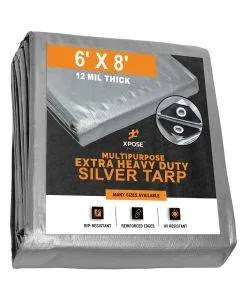Poly Tarps The Essential Guide to Versatile, Durable, and Affordable Covers
Poly tarps, also known as polyethylene tarps, are a staple in many households, businesses, and industries. Their durability, affordability, and versatility make them a go-to solution for a wide range of applications. Whether you need to cover equipment,Extra Heavy Duty White Tarps protect against the elements, or create temporary shelters, poly tarps offer an efficient and cost-effective solution. This article will explore everything you need to know about poly tarps, including their benefits, types, uses, and tips for choosing the right tarp for your needs.
What Are Poly Tarps?
Poly tarps are made from woven polyethylene, a type of plastic that is known for its strength and flexibility. The material is often coated with a UV-resistant layer, making it suitable for both indoor and outdoor use. Poly tarps come in various thicknesses, colors, and sizes, providing options for different applications.
Benefits of Poly Tarps
Poly tarps offer several advantages that make them a popular choice for various uses:
Affordability: Poly tarps are cost-effective,white tarp heavy duty making them accessible for a wide range of budgets. They offer an economical solution for covering and protecting items.
Durability: Despite their lightweight nature, poly tarps are remarkably durable. They resist tears, punctures, and wear, providing long-lasting protection.
Waterproof and Weather-Resistant: Poly tarps are highly resistant to water and can withstand various weather conditions, including rain, snow, and sun, making them ideal for outdoor use.
UV Protection: Many poly tarps are treated to resist UV rays, preventing degradation and extending their lifespan when used outdoors.
Versatility: Poly tarps can be used for a multitude of purposes, from covering vehicles and equipment to creating temporary shelters and protecting construction sites.
Ease of Use: They are lightweight and easy to handle, making them convenient for quick setup and removal.
Types of Poly Tarps
Poly tarps come in different types, each suited for specific applications:
Light-Duty Poly Tarps: These tarps are typically 5-8 mils thick and are suitable for lightweight applications such as covering furniture, providing temporary shade, or protecting items from light rain.
Medium-Duty Poly Tarps: With a thickness of 9-12 mils, medium-duty tarps are ideal for more demanding applications like covering boats, vehicles, and outdoor equipment.
Heavy-Duty Poly Tarps: These tarps range from 13-20 mils thick and are designed for heavy-duty use. They are perfect for construction sites, long-term outdoor storage, and protecting large machinery.
UV-Resistant Poly Tarps: These tarps are treated to resist UV rays, making them ideal for prolonged outdoor use where sun exposure is a concern.
Fire-Retardant Poly Tarps: Made with materials that resist ignition and slow the spread of flames, these tarps are suitable for areas where fire safety is crucial.
Reinforced Poly Tarps: These tarps have additional layers or fibers for added strength and durability, making them suitable for applications that require extra resilience.
Common Uses for Poly Tarps
Poly tarps are incredibly versatile and can be used in various settings:
Construction: Cover building materials, tools, and construction sites to protect them from weather damage and debris.
Agriculture: Use poly tarps to cover crops, hay bales, and equipment, or to create windbreaks and temporary shelters for livestock.
Camping and Outdoor Activities: Poly tarps are perfect for creating shelters, ground covers, and protecting camping gear from rain and sun.
Home Improvement: Protect floors, furniture, and other surfaces during painting, renovation, or cleaning projects.
Transport and Storage: Cover and secure items during transport or storage to protect them from weather and dust.
Emergency Uses: Use poly tarps for temporary repairs, creating makeshift shelters, or providing quick coverage in emergency situations.
Choosing the Right Poly Tarp
When selecting a poly tarp, consider the following factors to ensure you get the right tarp for your needs:
Size: Measure the area or items you need to cover and choose a tarp that provides adequate coverage. It’s often best to select a tarp slightly larger than your requirements for complete protection.
Thickness: The thickness of a tarp affects its durability and suitability for different applications. Thicker tarps are more durable and better for heavy-duty use.
Color: Different colors serve different purposes. For example, silver or white tarps reflect heat, keeping covered areas cooler, while black or dark green tarps absorb heat.
Grommets and Reinforcements: Look for tarps with reinforced edges and heavy-duty grommets for secure attachment. This prevents tearing and ensures the tarp stays in place.
UV and Fire Resistance: If you plan to use the tarp outdoors for extended periods or in areas with fire hazards, choose a tarp with UV or fire-resistant properties.
Quality: Opt for high-quality tarps from reputable manufacturers to ensure longevity and reliability.
Where to Buy Poly Tarps
Poly tarps are widely available from various retailers:
Online Stores: Websites like Amazon, eBay, and specialized tarp suppliers offer a broad selection of poly tarps with user reviews and competitive pricing.
Hardware Stores: Local hardware stores such as Home Depot or Lowe's carry a range of poly tarps, allowing you to see and feel the product before purchasing.
Outdoor and Camping Stores: Stores specializing in outdoor gear often stock poly tarps suitable for camping and recreational use.
Construction Supply Stores: For heavy-duty applications, construction supply stores offer a variety of poly tarps designed for industrial use.
Caring for Your Poly Tarp
Proper care and maintenance can extend the life of your poly tarp:
Clean Regularly: Wash off dirt and debris with a mild soap solution and rinse thoroughly. Allow the tarp to dry completely before storing.
Store Properly: Fold the tarp neatly and store it in a cool, dry place to prevent mildew and damage.
Inspect for Damage: Regularly check for tears or holes and repair them promptly to maintain the tarp’s integrity.
Avoid Sharp Objects: Be cautious when handling the tarp around sharp objects to prevent punctures and tears.
Secure Properly: Ensure the tarp is securely fastened to avoid flapping and potential damage from wind.

Comments
Post a Comment